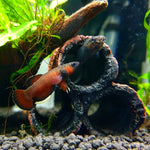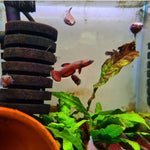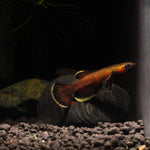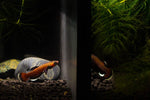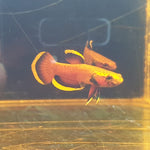albimarginata: from the Latin albus, meaning white, and margo, meaning margin, alluding to the white fin margins.
Appears endemic to the Sebuku River drainage in Kalimantan Timur (East Kalimantan) province, Indonesia, Borneo.
Type locality is ‘Sungei Sanul, tributary of Sungei Tikung, Sungei Sebuku basin’.
Naturally inhabits forest streams with moderate flow where it inhabits very shallow (depth ~5-10 cm) water among marginal plants roots and leaf litter.
25 – 30 mm.
An aquarium with base measurements of 45 ∗ 30 cm could house a pair or small group.
Can be maintained in a fully-decorated aquarium although many breeders prefer not to use a substrate for ease of maintenance.
Driftwood roots and branches can be used and placed such a way that a few shady spots are formed while clay plant pots or lengths of piping can also be included to provide further shelter.
The addition of dried leaf litter further emphasises the natural feel and as well as offering additional cover for the fish brings with it the growth of microbe colonies as decomposition occurs.
These can provide a valuable secondary food source for fry and the tannins and other chemicals released by the decaying leaves are also considered beneficial for fishes from blackwater environments.
There is no need to use natural peat, however, the collection of which is both unsustainable and environmentally-destructive.
Like others in the genus this species seems to do best under fairly dim lighting.
You could add aquatic plant species that can survive under such conditions such as Microsorum, Taxiphyllum or Cryptocoryne spp., and a few patches of floating vegetation would be useful as well.
This species requires acidic conditions with negligible carbonate hardness and very low general hardness so a reverse osmosis unit or other method of obtaining soft water may need to be employed, and this can be further acidified using phosphoric acid or similar if necessary.
As it naturally inhabits sluggish waters filtration should not be too strong, with an air-powered sponge filter set to turn over gently adequate.
Keep the tank well-covered and do not fill it to the top as like all Betta spp. it requires occasional access to the layer of humid air that will form above the water surface, and is an excellent jumper.
Temperature: 23 – 28 °C
pH: 4.0 – 6.5
Hardness: 18 – 90 ppm
Likely to prey on insects, other small invertebrates and zooplankton in nature.
Captive fish will normally accept dried products once they’re recognised as edible, but should be offered plenty of small live or frozen foods such as Daphnia, Artemia or bloodworm regularly to ensure development of optimal colour and condition.
Take care not to overfeed as Betta spp. seem particularly prone to obesity.
Not recommended for the standard community set-up for reasons already touched upon.
It’s requirements and disposition mean it’s best kept alone or with small, peaceful species since much bigger or more vigorous fishes are likely to intimidate and outcompete it.
Some small cyprinids and loaches that inhabit similar environments in nature are compatible but proper research is essential.
It can be maintained in a pair or group and will display some interesting behavioural interactions under the latter circumstances.
Adult males are more colourful and have a broader head shape than females.
Paternal mouthbrooder. Organise a separate tank for breeding purposes unless the fish are already being maintained alone, setting this up as suggested above.
The tank should have the tightest-fitting cover you can find (some breeders use clingfilm instead to ensure no gaps) as the fry need access to a layer of warm, humid air without which development of the labyrinth organ can be impaired.
Following a protracted courtship, eggs and milt are released during an ’embrace’ typical of anabantoids in which the male wraps his body around that of the female.
Several ‘dummy’ embraces may be required before spawning commences.
Fertilised eggs are caught on the anal fin of the male then picked up in the mouth of the female before being spat out into the water for the male to catch.
Once the male has all the eggs in his mouth the cycle is repeated untill the female is spent of eggs, a process which can take some time.
Brood size is quite small, with even 10 eggs being considered a good number.
A brooding male may swallow or release the eggs prematurely if stressed or inexperienced, so it’s preferable to leave the female and any other fishes in situ.
The incubation period is 10 – 21 days at the end of which the male will begin to release fully-formed, free-swimming fry.
At this point they can be removed or left to be reared alongside the adults, which will not normally harm them.
The fry are large enough to accept motile foods such as microworm and Artemia nauplii immediately, though it should be noted that there exist reports of young Betta developing health issues if fed excessive amounts of the latter.
Offer small amounts of different foods 2 -3 times per day for optimal growth rate, and don’t change too much water at once, with regular, small changes preferable to intermittent larger ones.

